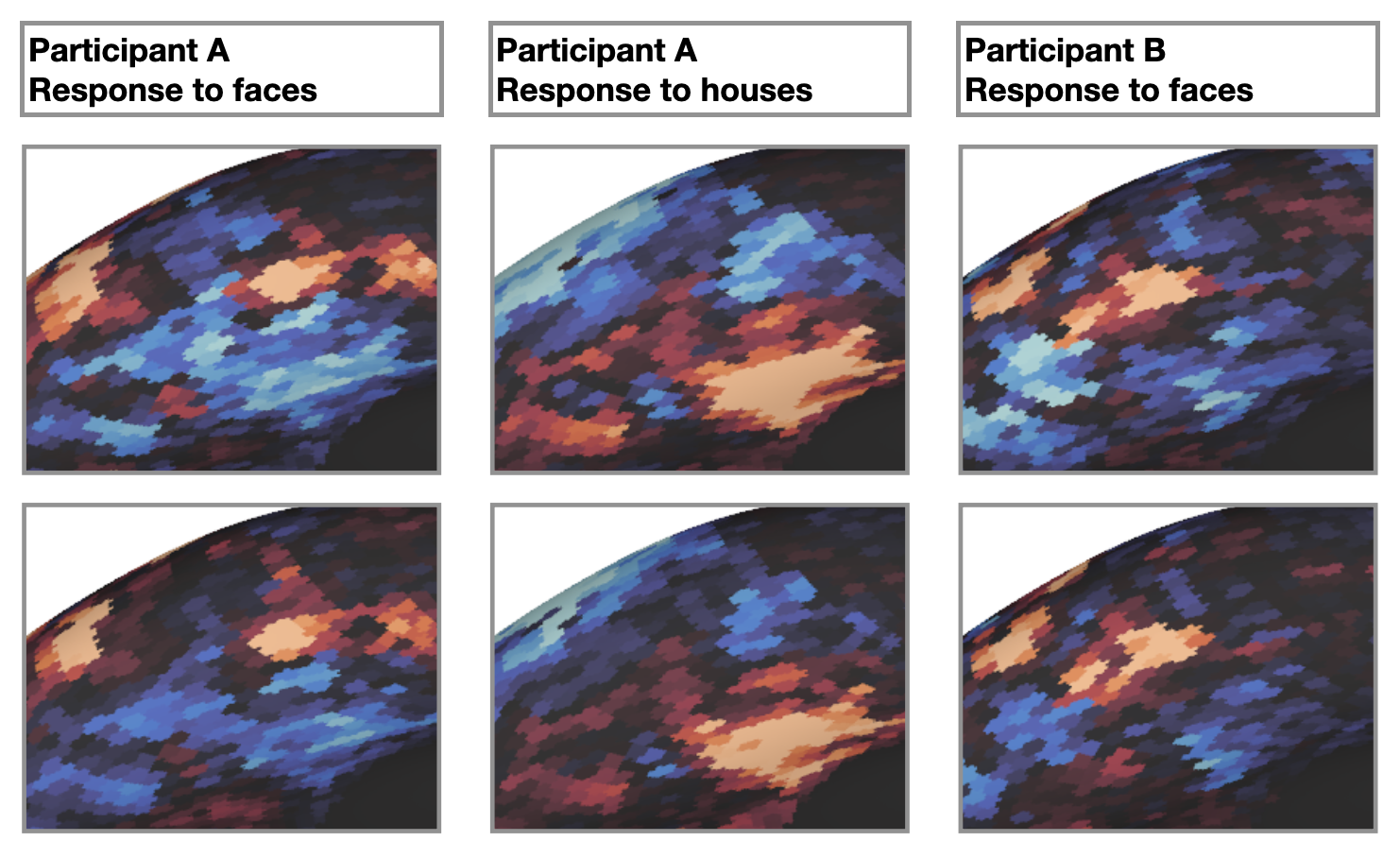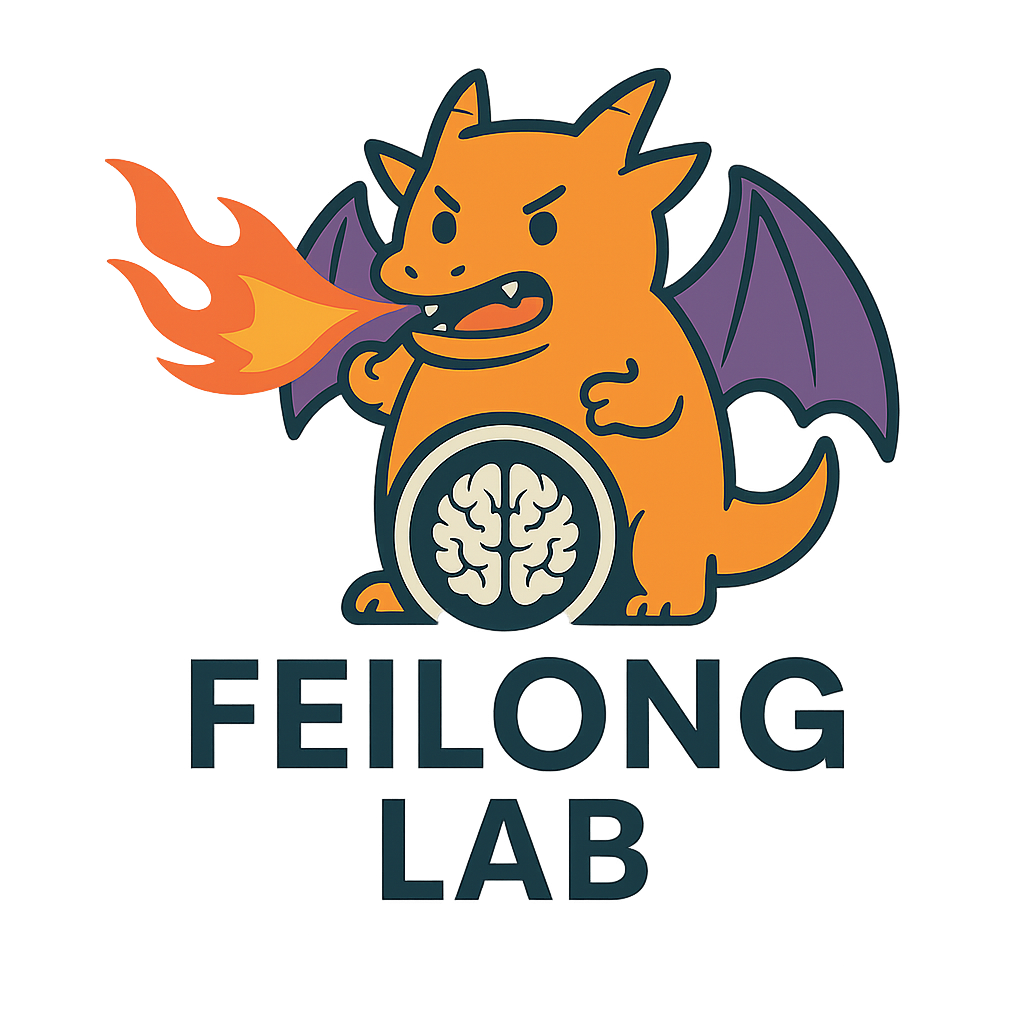Predicting individualized brain responses#
Topographic idiosyncrasies#
Different brains encode the same information in distinct ways [Haxby et al., 2020]. Across individuals, the same brain function may be implemented in different anatomical locations, while the same anatomical region may support different functions. These idiosyncrasies in the correspondence between function and anatomy—often referred to as topographic idiosyncrasies—pose a major challenge for studying brain function across individuals.

Fig 1. Topographic idiosyncrasies. Within each brain, response patterns to a given stimulus are reliable across independent measurements (top and bottom rows). The brain shows distinct response patterns to different stimuli (left and middle columns). However, across brains, response patterns to the same stimulus differ (left and right columns). See Feilong and Zhang [2025] for a discussion of how these idiosyncrasies can be resolved
Predicting individualized brain responses#
To study these functional regions, rather than anatomical locations, researchers often use functional localizers to identify these regions in each individual brain. However, acquiring such data can be challenging in many studies. Hyperalignment [Haxby et al., 2020], a functional alignment method, provides a powerful solution to this problem. Hyperalignment establishes functional correspondence across individuals, allowing for projecting fMRI data from one brain to another. The projected data, particularly when aggregated across multiple source individuals, can serve as an accurate prediction of the target individual’s brain responses to the same stimuli [Feilong et al., 2023, Guntupalli et al., 2016, Haxby et al., 2011, Jiahui et al., 2020, Jiahui et al., 2023].

Fig 2. Predicting individualized brain responses using the INT model. The top row shows the face-selectivity map and eccentricity map based on the localizer scans. The bottom row shows the predicted maps using the Individualized Neural Tuning (INT) model [Feilong et al., 2023]. Note that the localizer-based maps are not noise-free, and the differences between the predicted and localizer-based maps partly reflect noise in the localizer data.
References#
James V Haxby, J Swaroop Guntupalli, Samuel A Nastase, and Ma Feilong. Hyperalignment: modeling shared information encoded in idiosyncratic cortical topographies. elife, 9:e56601, 2020. doi:https://doi.org/10.7554/eLife.56601.
Ma Feilong, Samuel A Nastase, Guo Jiahui, Yaroslav O Halchenko, M Ida Gobbini, and James V Haxby. The individualized neural tuning model: precise and generalizable cartography of functional architecture in individual brains. Imaging Neuroscience, 1:1–34, 2023. doi:https://doi.org/10.1162/imag_a_00032.
Ma Feilong and Yuqi Zhang. Advancing neural decoding with deep learning: computational neuroscience. Nature Computational Science, pages 1–2, 2025. doi:https://doi.org/10.1038/s43588-025-00837-2.
Guo Jiahui, Ma Feilong, Matteo Visconti di Oleggio Castello, J Swaroop Guntupalli, Vassiki Chauhan, James V Haxby, and M Ida Gobbini. Predicting individual face-selective topography using naturalistic stimuli. NeuroImage, 216:116458, 2020. doi:https://doi.org/10.1016/j.neuroimage.2019.116458.
Guo Jiahui, Ma Feilong, Samuel A Nastase, James V Haxby, and M Ida Gobbini. Cross-movie prediction of individualized functional topography. Elife, 12:e86037, 2023. doi:https://doi.org/10.7554/eLife.86037.
J Swaroop Guntupalli, Michael Hanke, Yaroslav O Halchenko, Andrew C Connolly, Peter J Ramadge, and James V Haxby. A model of representational spaces in human cortex. Cerebral cortex, 26(6):2919–2934, 2016. doi:https://doi.org/10.1093/cercor/bhw068.
James V Haxby, J Swaroop Guntupalli, Andrew C Connolly, Yaroslav O Halchenko, Bryan R Conroy, M Ida Gobbini, Michael Hanke, and Peter J Ramadge. A common, high-dimensional model of the representational space in human ventral temporal cortex. Neuron, 72(2):404–416, 2011. doi:https://doi.org/10.1016/j.neuron.2011.08.026.
